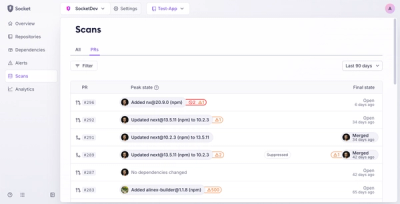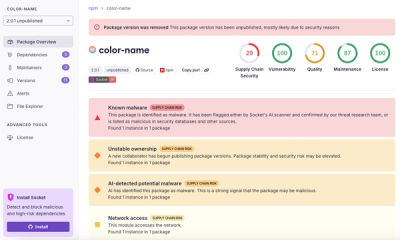
Product
Introducing Pull Request Stories to Help Security Teams Track Supply Chain Risks
Socket’s new Pull Request Stories give security teams clear visibility into dependency risks and outcomes across scanned pull requests.
webgen is used for generating static websites from templates and content files (which can be written in any markup language). It can generate dynamic content like menus on the fly and comes with many powerful extensions.
Sponsors:
The author of webgen is Thomas Leitner -- he is reachable at mailto:t_leitner@gmx.at.
You can discuss webgen or find help on the webgen-users Google group.
Or you can join the IRC channel #webgen on Freenode.
webgen is a free (GPL-licensed) command line application for generating static websites. It combines content with template files to generate HTML files. This allows one to separate the content from the layout and reuse the layout for many content files.
Apart from this basic functionality, webgen offers many features that makes authoring websites easier:
Multiple markup languages to choose from for writing HTML and CSS files (Markdown, Textile, RDoc, Haml, Sass, ...)
Automatic generation of menus, breadcrumb trails, ... and more!
Partial website regeneration (only modified items get re-generated) which reduces website generation time enormously
Self-contained website (all generated links are relative, so one can view the website without a web server)
Easily extendable (all major components can be extended with new functionality or existing functionality can be replaced)
No need to know the Ruby language for basic websites
The main documentation lives at http://webgen.gettalong.org/documentation/.
webgen is written in Ruby, so you need the Ruby interpreter on your system. You can get it from http://ruby-lang.org/. See http://webgen.gettalong.org/installation.html for more information.
You can install webgen via Rubygems:
$ gem install webgen
Or via the setup.rb method if you have downloaded a tarball or zip file:
$ ruby setup.rb config
$ ruby setup.rb setup
$ ruby setup.rb install
GPLv3 - see the COPYING file.
FAQs
Unknown package
We found that webgen demonstrated a not healthy version release cadence and project activity because the last version was released a year ago. It has 1 open source maintainer collaborating on the project.
Did you know?

Socket for GitHub automatically highlights issues in each pull request and monitors the health of all your open source dependencies. Discover the contents of your packages and block harmful activity before you install or update your dependencies.

Product
Socket’s new Pull Request Stories give security teams clear visibility into dependency risks and outcomes across scanned pull requests.

Research
/Security News
npm author Qix’s account was compromised, with malicious versions of popular packages like chalk-template, color-convert, and strip-ansi published.

Research
Four npm packages disguised as cryptographic tools steal developer credentials and send them to attacker-controlled Telegram infrastructure.